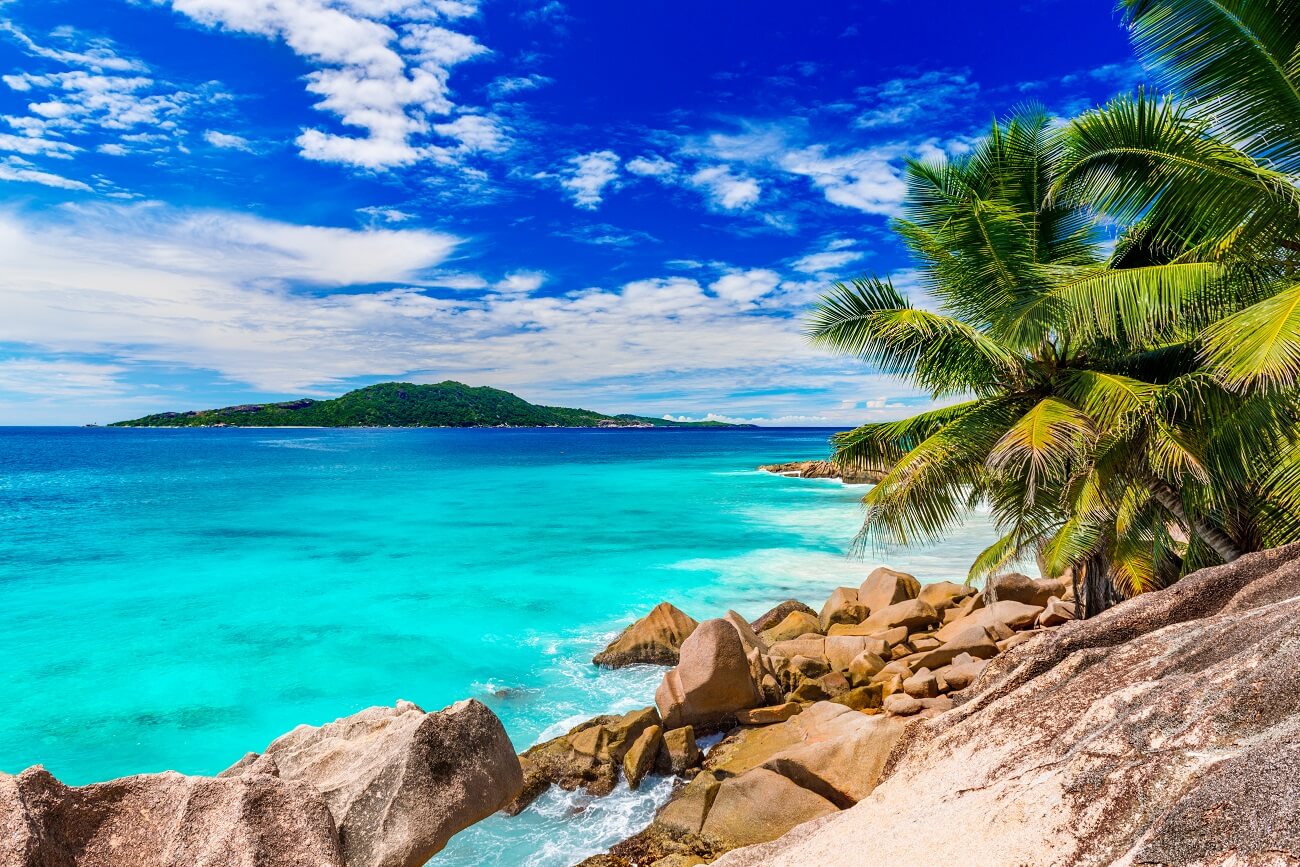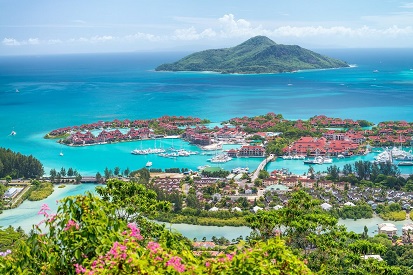

The Seychelles is a land of amazing turtles that you won’t find almost anywhere else!
The Seychelles giant tortoise, also known as the Aldabra tortoise , belongs to an ancient group of reptiles that appeared on earth about 250 million years ago. According to research, the first turtles appeared in the Seychelles about 2 million years ago. They were brought here by ocean currents from continental Africa: they traveled more than 1,500 kilometers.
The Seychelles tortoise, also called the elephant tortoise, is the largest land turtle. It can reach 1.3 meters in length and weigh more than 400 kilograms. These adorable creatures are the longest-living land animals on the planet: they can live for more than 200 years. The turtle got its name from Aldabra Atoll , where it first appeared. Their population is estimated at 150,000 tortoises, 100,000 of which live on Aldabra , where they face no predators.

Depositphotos
Interesting facts about turtles Seychelles
- Seychelles tortoises live solitary lives, but gather in open areas to eat.
- They live in arid areas where there is little fresh water. During the hottest hours, they take refuge in muddy puddles or in the shade of bushes. During the dry season, they make do with the water contained in the plants they eat. When it rains, they drink from puddles through their nostrils!
- The breeding season lasts from February to May. The female carries fertilized eggs with her for 110 to 250 days until she lays a clutch of them in a shallow nest. The female lays her eggs in a hole in the ground, which she fills up before leaving so as not to return. The eggs hatch 3-7 months after being laid. Incubation time depends on the outside temperature. Newborn turtles are very small - 6 cm with an average weight of 45 g.
- In the wild, a clutch will consist of 4 to 14 eggs, while in captivity this number increases from 9 to 25. However, in both cases, only 30 to 50% of these eggs hatch . When the young hatch , they live independently and reach sexual maturity between 20 and 30 years of age. Turtles know how to regulate their population. At high population densities, the female lays only 4-5 eggs every few years. And at low densities, up to 14 eggs are laid several times a year.
- The Seychelles tortoise is slightly larger than the Galapagos tortoise. Males are 20-30% larger than females.
- Turtles primarily eat grass, leaves, plant stems, and fruits. Thanks to its long neck, the turtle can reach branches up to one meter high. They spend most of their time searching for food.
- Most turtles live between 80 and 120 years. The oldest giant tortoise lived to be 255 years old.
- Mating occurs from February to May, and egg laying occurs from June to September.

Depositphotos
The history of the extermination of giant tortoises
Historically, giant tortoises were found on most Indian Ocean islands, but they gradually became extinct. When people arrived in the Seychelles, turtles began to suffer from mass hunting and destruction of their habitat. European colonists arrived in the Seychelles in the 18th century, and the population of giant tortoises was then large.
Turtles were an excellent food source: these large creatures provided a lot of meat and required little care. The sailors simply loaded them onto ships, and over time killed and eaten them during the voyage.
In addition, among the first colonists were farmers who brought cattle to the islands. He began to displace giant turtles from their usual habitats. Goats brought to the island have become serious food competitors for Seychelles tortoises. Wild artiodactyls turned out to be active hunters of turtles: they break the shell with their hooves and devour their meat.
Turtles have also become victims of deforestation as their habitats have been used for agriculture and timber extraction.
As a result of all these factors, the turtle population has greatly decreased. At the beginning of the 20th century, the turtle population was so decimated that some species were considered extinct. There is evidence that the number of turtles in the Seychelles has decreased by 90% since first contact with European colonists.
The Seychelles giant tortoise is the only one of the 18 species of giant tortoises that has not gone extinct.
Fortunately, thanks to the efforts of the Seychelles government , the turtles were saved from complete extinction. A ban has been introduced on hunting them and the creation of reserves where turtles are provided with conditions for reproduction and growth.
Efforts to bring the species back from the brink of extinction have led to the release of more giant tortoises into the wild. Today in the Seychelles, turtles can be seen on many islands, including protected areas. They have become one of the symbols of the Seychelles and attract tourists from all over the world.

Depositphotos
Esmeralda and Jonathan: the most famous turtles of the Seychelles
One of the oldest living turtles in the world lives on Bird Island in the Seychelles. Esmeralda's age is estimated at 175 years: she was included in the Guinness Book of Records as the heaviest living turtle - 360 kg at the last weigh-in! Tourists can visit Esmeralda and even take a photo with this famous centenarian.
Another famous Seychelles tortoise is Jonathan, who has reached 190 years of age.

Depositphotos
Where to find turtles in the Seychelles
Giant tortoises live on various islands of the Seychelles archipelago, including Mahe , Fregate, Xavier , La Digue , Aldabra , Curieuse and others. Some of these islands have limited access for tourists and require special permission to visit.
- Anne's Marine National Park
The best place to see giant tortoises in the Seychelles is St. Anne's Marine National Park. This national park consists of 6 small islands off the northeast coast of Mahe Island . It has stunning sandy beaches, tropical vegetation and lots of great hiking trails. Getting to the islands alone can be difficult, so it's best to join a boat tour that takes you to the islands.
- Moyenne Island . The best place to see giant tortoises is in Seychelles as there are not many tourists here. This is mainly due to its more secluded location: you need to take a boat to get there.
- Curious Island . Curieuse Island is a national park. It's a small, unspoiled island with quiet beaches, giant turtles and lush mangrove forest. Turtles simply roam freely around the island: there are more than 200 of them! There is a turtle nursery where the cubs are raised until they reach 5 years of age, and then released into the wild. In addition to giant tortoises, the island is also home to the Coco de Mer palm. Before leaving the turtle sanctuary in the Seychelles, you can choose a turtle and take “patronage” over it: a photo of the turtle will be sent to you by email .
- L'Union Park The estate is located in the southern part of the island of La Digue . It is a former coconut and vanilla plantation that provides insight into the islands' colonial past. It is also home to several magnificent giant tortoises. You can join a day tour of the Seychelles that takes you around La Digue .
- Desroches . Another island in the Seychelles where you can see giant turtles. If you are looking for a luxury holiday then this is ideal as you can stay at the Four Hotel Seasons Resort Seychelles . This secluded paradise feels like you're on your own private island as Four Seasons is the only hotel on the island. Desroches is home to about 150 giant tortoises, many of which roam freely on the island. The island is also home to a turtle sanctuary where guests can learn all about these beauties .
- Mahe . There are not many turtles on the island of Mahe , but there are some at the Seychelles National Botanical Garden in Victoria. Here you can admire trees and flowers, as well as a variety of wildlife, including birds, fruit bats and giant tortoises. You can even feed these big beauties ! The staff will give you leaves to give to the turtles, giving you the opportunity to get up close and personal with them.
- Aldabra . Aldabra Atoll in the Seychelles is the jewel of the Indian Ocean with its incredible marine and coral biodiversity . Aldabra Atoll , a ring of four large coral islands around a shallow lagoon, is one of those natural wonders we love to see in beautiful books. It is home to the largest population of giant land tortoises in the world. Aldabra is home to approximately 100,000 giant tortoises, representing about 15% of the world's total number of giant tortoises. They are at the top of the food chain, having no natural enemies on the island, and therefore are not afraid of people. In the 1960s, they were going to establish an air base here, which would have become a threat to the population. But due to protests from residents, the project was rejected. In 1975, a natural reserve with an area of 19,000 hectares was created on Aldabra , where all economic activities are prohibited. There is a research station for studying turtles on the atoll. It is very difficult to visit this island: only about 900 visitors a year. This can only be done with organized excursions, since visiting the island on your own is prohibited; before visiting, you must obtain an entry permit. The permit is issued only to travel companies and is valid for a limited period. This island has been protected from human influence and is in fact a UNESCO World Heritage Site. About 37 kilometers southwest of the atoll is an island where India wants to build a military base, and the Seychelles government plans to hand over control of the island to India for 20 years. Environmentalists are afraid of this prospect and the possible consequences for turtles.

Depositphotos
Don't miss the opportunity to see giant beauties and capture a colorful photo with them: visit the Seychelles now!
More articles
- Rains in Bali: pros and cons of the wet season
- Hotels of Ayana complex in Bali
- Gunung Batur: how to get to the main volcano in Bali
- Likupang on Sulawesi Island in Indonesia
- Mauritius Attractions: 27 Best Places to Visit
- Bali for Two: 24 Romantic Getaway Ideas
- Top 20 Bali Tours: Itineraries, Offers, and Prices
- Bali's Best Beach Clubs - 13 Luxury Oases
- Tips for tourists in Indonesia - how to avoid spoiled holidays
- Yoga Studios in Bali - where to catch Zen on the Island of the Gods



